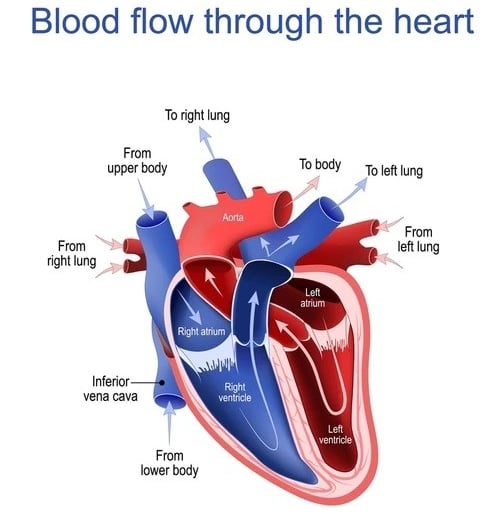

The blood flow through the heart follows a specific pathway, ensuring that blood is pumped to the lungs for oxygenation and then to the rest of the body to supply oxygen and nutrients. Here’s a detailed step-by-step description of the blood flow through the heart:
1. Deoxygenated Blood Returns to the Heart
From the body: Deoxygenated blood from the body returns to the heart through two large veins:
The superior vena cava (from the upper body)
The inferior vena cava (from the lower body)
Entry point: The blood enters the right atrium of the heart.
2. Right Atrium to Right Ventricle
Atrial contraction: The right atrium contracts, pushing the deoxygenated blood through the tricuspid valve into the right ventricle.
3. Right Ventricle to the Lungs
Ventricular contraction: When the right ventricle contracts, the blood is pushed through the pulmonary valve into the pulmonary artery.
Pulmonary circulation: The pulmonary artery carries the deoxygenated blood to the lungs, where it becomes oxygenated (receives oxygen and releases carbon dioxide).
4. Oxygenated Blood Returns to the Heart
From the lungs: Oxygenated blood returns to the heart through four pulmonary veins.
Entry point: The blood enters the left atrium of the heart.
5. Left Atrium to Left Ventricle
Atrial contraction: The left atrium contracts, pushing the oxygenated blood through the bicuspid valve into the left ventricle.
6. Left Ventricle to the Body
Ventricular contraction: The left ventricle contracts with great force, pushing the oxygenated blood through the aortic valve into the aorta.
Systemic circulation: The aorta, the largest artery in the body, carries the oxygen-rich blood to the entire body. The blood travels through smaller arteries, arterioles, and capillaries to supply oxygen and nutrients to tissues and organs.
Summary of Blood Flow Through the Heart:
Deoxygenated blood enters the right atrium via the superior and inferior vena cava.
Blood flows from the right atrium through the tricuspid valve into the right ventricle.
The right ventricle pumps the blood through the pulmonary valve into the pulmonary artery, which carries it to the lungs for oxygenation.
Oxygenated blood returns from the lungs to the left atrium through the pulmonary veins.
Blood flows from the left atrium through the bicuspid valve into the left ventricle.
The left ventricle pumps the oxygen-rich blood through the aortic valve into the aorta for distribution to the entire body.
Key Points:
The right side of the heart (right atrium and right ventricle) pumps deoxygenated blood to the lungs.
The left side of the heart (left atrium and left ventricle) pumps oxygenated blood to the rest of the body.
The heart has two circulatory circuits: the pulmonary circulation (to and from the lungs) and the systemic circulation (to and from the body).
This efficient and coordinated flow ensures that the body receives oxygenated blood while also removing waste products, like carbon dioxide, through the lungs. The heart beats about 100,000 times per day, pumping five or six quarts of blood per minute.
Anatomy Useful Links
